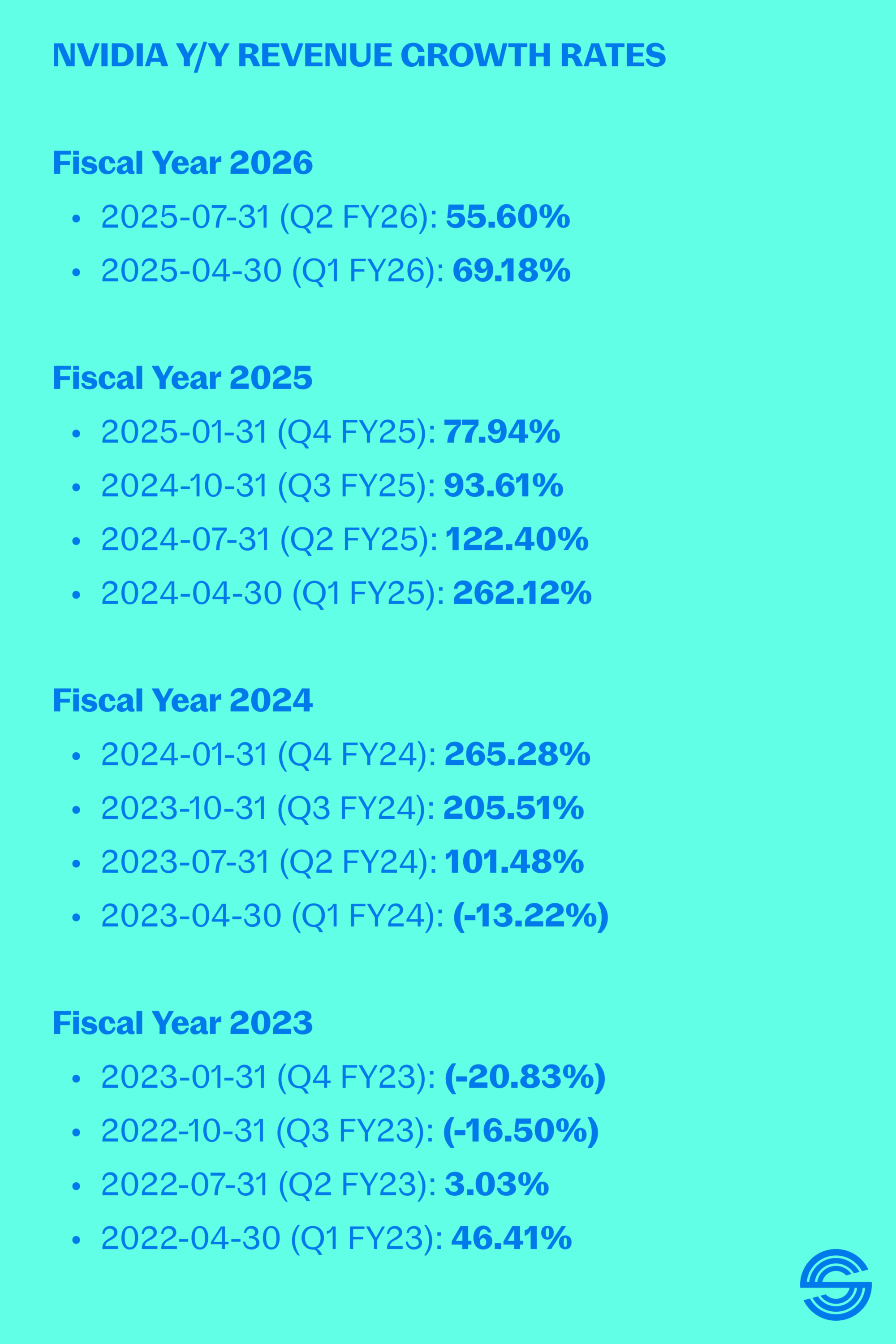The Small NVIDIA Short

Tomorrow is once again the big day. Will Jensen Huang see his shadow? NVIDIA's results will determine if utter AI exuberance gets to continue for another few months or, in a reversal with Punxsutawney Phil's model, if AI Winter is coming.
I make this joke every quarter, but it's also more of an acute risk every quarter. NVIDIA famously became the first $5T company in history a few weeks ago. Alongside that milestone, it surpassed accounting for 8% of the S&P 500 – the largest single-stock weight in the history of the index. Increasingly, as goes NVIDIA, so goes the stock market. So yeah, Jensen seeing his shadow is important.
As to if he will or not, there are conflicting signs. By all accounts, AI spend – and in particular, Big Tech CapEx spend – continues to surge. Given just how much of that spend runs directly to and through NVIDIA, it seems almost impossible to believe they could disappoint on earnings. At the same time, the Law of Large Numbers exists in business for a reason. The bigger you are, the harder it is to grow bigger still at the same rate of growth. And, of course, NVIDIA's rate has been falling for a while now.
In the chart below, you can plainly see the brief rise and fast fall of the crypto boomlet and then the utterly insane rise of AI starting in mid-2023.

Again, this chart isn't surprising, it's that Law of Large Numbers at work. If anything, it's insanely impressive that NVIDIA is still seeing growth north of 50% given the scale they're at and the previous year's comps. But at some point, barring some new breakthrough – which obviously is certainly possible and perhaps even plausible in this world! – NVIDIA will fall back to more "normal" rates of quarterly revenue growth. While they're all obviously different businesses (with some overlap), the rest of Big Tech – the largest companies in the world – have yearly growth rates ranging from 8% (Apple) to Meta (26%).
NVIDIA itself is guiding towards around 54% growth this quarter, while Wall Street consensus has them in the 56% to 60% range. The latter would be rather incredible because it would be the first sequential uptick in that growth rate since the end of 2023/early 2024, nearly two full years ago. Regardless, this is undoubtedly going to be the first $50B revenue quarter in the history of the company.
And even if NVIDIA was able to pull off the accelerated growth, the real key, as always, will be what they're guiding towards next quarter (current Wall Street bets are in the 56% growth rate range there as well). And there are a lot of constantly-in-motion pieces there between the shipment of new chips and the China situation (if and when NVIDIA is able to do business in China again, the numbers will clearly surge and should easily beat any estimates since they're no longer accounting for any China sales in their models for the AI chip business, and it used to be a pretty good part of the business!).
There's also new wild cards potentially in play in NVIDIA's quarterly numbers thanks to their increasing number (and increasing in size) stakes in other AI companies – most notably, OpenAI itself. How will they account for the swings in value there? Will their accountants determine that they need to account for some of that startup's sizable losses on their own books as Microsoft does? Presumably not since the stake is still very small (~2%) and only growing to a potentially sizable one over time. So instead they'll have to mark to market which will impact their bottom line (though presumably not yet in a major way beyond a uptick in their previous smaller holding due to the new round of financing). And what about all the other stakes?
Also, what about those two key customers that we so key to last quarter?
The Bear
Almost all of the above lays out a picture where NVIDIA's business is still booming for the foreseeable future. But that doesn't mean there aren't signs of concern – in the form of a few big bets against them (or no longer for them), in particular.
The biggest of these, of course, is the short position perhaps the most famous short-seller in history, Michael Burry, disclosed a couple weeks ago. To be clear, he's far more short on, and presumably bearish on, Palantir. But still, before he closed up his shop (or at least deregistered it with the SEC), Burry made two final short bets and one of those is on the most valuable company in the world.
Burry followed up with some hints that he's in particular worried about the depreciation schedule that the tech companies are using for their data center assets – the biggest aspect of that is clearly the lifespan of NVIDIA chips. He suggests that this element alone is a form of financial manipulation that helped inflate the current AI bubble.
At the same time, if that's his rationale – or even just a key part of his bubble thesis – why would he short Palantir so heavily versus, say, the "neocloud" companies? Their business models are heavily predicated around this depreciation element. As I wrote in (the paid version of) the newsletter last week:
I'm honestly not quite sure what to make of Michael Burry's move to shutter his fund (or at least deregistering it with the SEC) right after making his short bet on Palantir (and to a lesser extent NVIDIA). His stated reason that the value of securities is not "in sync with the markets" sort of implies he's giving up on the short game because the market is too irrational, and that this may be his swan song bet? But it's almost too obvious of one to make given where Palantir is valued relative to earnings. And ditto with NVIDIA given that it's, well, the most valuable company in the world on the back of AI. Why not short neoclouds or something else if you really believe AI is a bubble? Especially with his follow-up talk about potential nefarious business going on with the way companies are handling depreciation of these chips – this is clearly going to be an issue for someone at some point given how all over the board the timelines are: some 3 years, some 4, some 5, CoreWeave um, 6! And it is interesting that these shifts have happened while NVIDIA has also shifted from a two year release cadence to a one year (which Satya Nadella mentioned almost in passing on The Dwarkesh Podcast this week when talking about why they paused some data center spend earlier this year – yeah...) Anyway, Palantir is all kinds of complicated because of the government contracts if nothing else. And, of course, Burry was just wrong with his infamous last "Sell" tweet. So what's the game afoot here? I guess we'll know more on November 25! Thanksgiving stuffing coming early this year?
But Burry also isn't the only one making a bet here. Or perhaps more accurately, there are others pulling their bets on NVIDIA.
SoftBank made headlines last week with the news that they were selling their entire multi-billion-dollar position in NVIDIA. They were quick to note that this was simply to get cash to be able to fulfill their commitments to fund OpenAI, but it's still a signal against NVIDIA. If SoftBank was super bullish about the company's growth prospects from here – as they clearly are on OpenAI – presumably they would have figured out a way to sell other assets and/or take on more debt to make those payments. It's not stated but certainly implied that they were okay selling their NVIDIA position right now at these prices.
And that's especially eye-opening since one of Masa Son's greatest regrets that he has often talked about in recent years was exiting the NVIDIA stake he previously held. Of course, that's also easy and obvious to say when you had a holding you sold for $4B (in 2019) that had you held would have been worth around $250B these days... Still, it's an interesting signal!
As is the move by Peter Thiel's hedge fund, Thiel Macro, to sell off their entire NVIDIA stake, as Bloomberg reported yesterday. Granted, the stake was "only" worth about $100M, but it was still one of the core holdings of the fund alongside Apple, Microsoft, and Tesla. They're holding on to those other holdings...
Even if the size of the sale wasn't going to move the stock, the news, especially in concert with the other items above, builds a narrative of negativity around NVIDIA at the moment. That might be fair or not (again, Burry's bet seemed more of a throw-in and SoftBank does need the cash), but it's out there.1 A big bear, circling the world's most valuable company...
The reality of the situation remains that while NVIDIA's numbers this quarter (and projections for next quarter) can certainly tank (or boost) the entire stock market given the sheer size and weight of the company, they're unlikely to lead to a full on bubble burst. If their numbers were ever bad enough, they could certainly kickstart such a sell-off (again, vice versa in the other direction if they're good enough), but bubbles are built on the back of irrationality.
I might argue that this particular bubble, the AI Bubble, is actually more rational than previous bubbles (and certainly the players involved are making that case). But that doesn't mean it's any less of a bubble. And bubbles always end. And that ending is even more likely to be for an irrational reason. That is, fear.
If and when something triggers a sell-off, what continues to fuel it won't be NVIDIA's numbers, it will be panic that the whole game is up and that the bets are now literally off. And that will feed back into the system, causing money to pull back which in turn will give companies less money to spend, which in turn will send less money to NVIDIA. And they'll be hit extra hard because of how entangled they are in the whole ecosystem at the moment.
I'm not saying this is about to happen. But I'm saying it will happen, at some point. Let's see if we see that shadow...
Update November 19, 2025: The numbers are out and NVIDIA has once again beaten across the board – including with that (slight) reacceleration of y/y revenue growth: 62%. Impressive. Shadow seen! 3 more months of AI!



1 It's more tangential, but I might also just note the disclosure revealing Berkshire Hathaway's large new position in Alphabet (now they're 10th largest holding). That's not necessarily a bet against NVIDIA, but you certainly might view it as a bet on Google being one of the key victors of the AI race. And if that's true, a large part of it will likely be the success of their TPU chips vs. NVIDIA's chips... ↩



